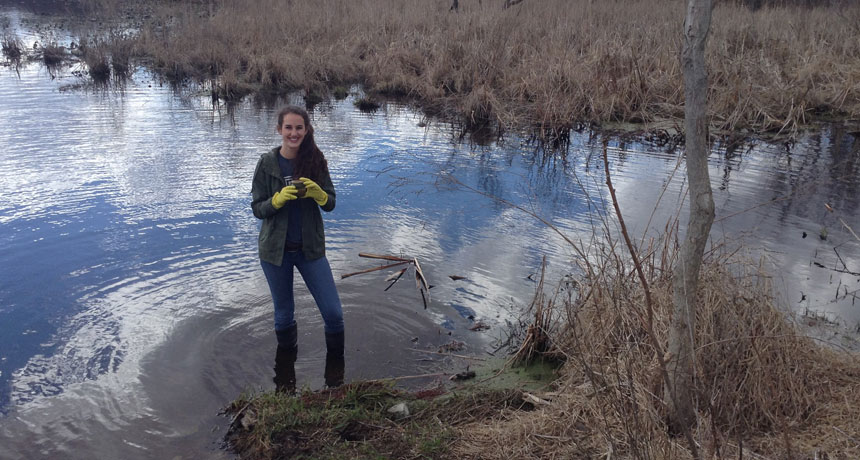Fighting big farm pollution with a tiny plant
A teen tackles lake pollution with local duckweed

Julia Hunckler collects local duckweed for her experiments. The teen studied whether the tiny plants could sop up fertilizer pollution.
J. Hunckler
PHOENIX, Ariz. — Sometimes a tap water ban can prove a scientific wakeup call.
When Toledo, Ohio told its residents not to drink tap water in 2014, Julia Hunckler, 17, took notice. This Marian High School junior lived across the state line in Mishawaka, Ind. The Ohio ban was due to toxins in Lake Erie. A summer bloom of algae had tainted the lake, which was used as a source of drinking water. Chemical fertilizers that washed off of nearby farms had been running into the lake. There, aquatic toxin-makers got a growth boost from the fertilizer. Julia decided to scout for something that might remove that algae booster. Her solution: a tiny freshwater plant.
Called duckweed, it indeed slurped up fertilizer. Later, that duckweed can be harvested as feed for local cows, Julia says.
The teen presented her findings, here, last month at the 2016 Intel International Science & Engineering Fair. Created by Society for Science & the Public and sponsored by Intel, this competition brought together more than 1,700 students from 75 countries to show off their science fair projects. (The Society also publishes Science News for Students.)
Farmer’s and gardeners fertilize their plants by feeding them extra growth-boosting nitrogen and phosphorus. But not all of the fertilizer stays in the plants or the soil around their roots. Some runs off in the rain, flowing into streams, rivers and lakes — including Lake Erie.
Those extra nutrients will fuel the growth of water organisms, too. Especially algae. Water rich in nutrients can cause these aquatic organisms to reproduce rapidly, or bloom. Because the algae float on the surface, those blooms can cut off sunlight to plants living below, causing some to die. Underwater plants produce oxygen. So their dying can cut oxygen levels in the water. As algae on the water surface also eventually die, bacteria will break them down. These microbes may then use up the remaining oxygen in the water. This oxygen-depleting cycle is known as eutrophication. And where it occurs there may be little oxygen left over for animals, such as fish.
But that may not be the only problem. Some types of algae are toxic. They produce one or more poisons that can harm fish. Those same toxins can poison people in the towns that rely on the lake for drinking water. That’s why Toledo had to warn residents not to drink their tap water.
“When I heard about the algae blooms in Lake Erie, I wanted to do something,” Julia says. She decided to focus on the source of the problem: the fertilizer. And it occurred to her that the tiny duckweed might be up to the job.
Turning to duckweed
Each plant is very small. Its tiny fronds run only 2 to 5 millimeters (0.08 to 0.2 inch) long. That’s less than half the length of a grain of rice. Each set of fronds has a single root that extends down into the water. Duckweed tends to grow in clusters that form dense mats at the surface.
This plant needs nitrogen and phosphorus, just as the algae do. Julia reasoned that duckweed might soak up some of the phosphorus from fertilizer runoff before it reached the algae.
To test this, she filled nine glass containers with water and then added phosphorus. To figure out just how much phosphorus to add, Julia used a test kit from her local pet store. Adding the kit’s chemicals to a water sample will turn it blue when phosphorus is present. Light blue signals a tiny amount. Dark blue points to a lot.
In three glasses, Julia added enough phosphorus to create the darkest blue possible. In three more, she added only enough to create the slightest blue tint. Then she added 50 duckweed plants from her local pond to each of the glasses. Three final glasses served as her controls. One had duckweed, but no phosphorus. The other two had no duckweed at all, just high or low levels of phosphorus.
After waiting 25 days, Julia carefully counted the number of fronds on each duckweed plant. She also measured the length of each plant’s root. Her goal was to tally how much each had grown. She also tested how much phosphorus remained in each glass of water.
Duckweed pulled the phosphorus out of both the high- and low-phosphorus water samples. In the process, the plants also “grew really, really fast,” Julia says. “I realized that this could cause a problem in the future if all of a sudden Lake Erie had a ton of duckweed.” After all, surface mats of duckweed can block out sunlight just as the algae can.
So the teen did more reading. She soon learned that duckweed is a nutritious food for cattle. All farmers would need to do is scoop it off the water. “Since it is easy to harvest, farmers could use the duckweed to feed to their cattle,” she concludes.
So far, the teen has data only from those nine cups of water. Eventually, she’d like to do experiments in Lake Erie itself. But first, she says, she’s got to get more data — and more duckweed.







